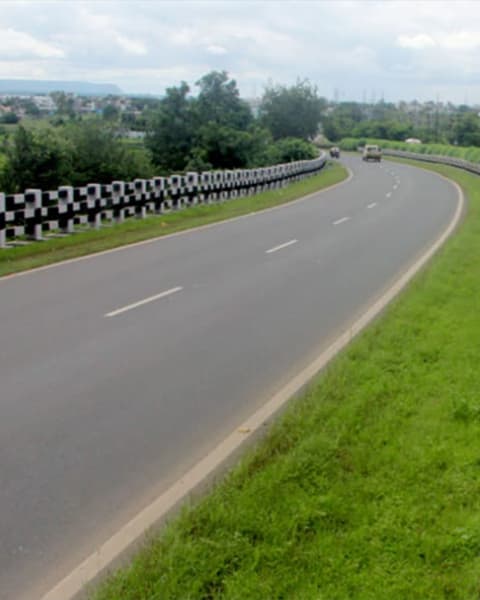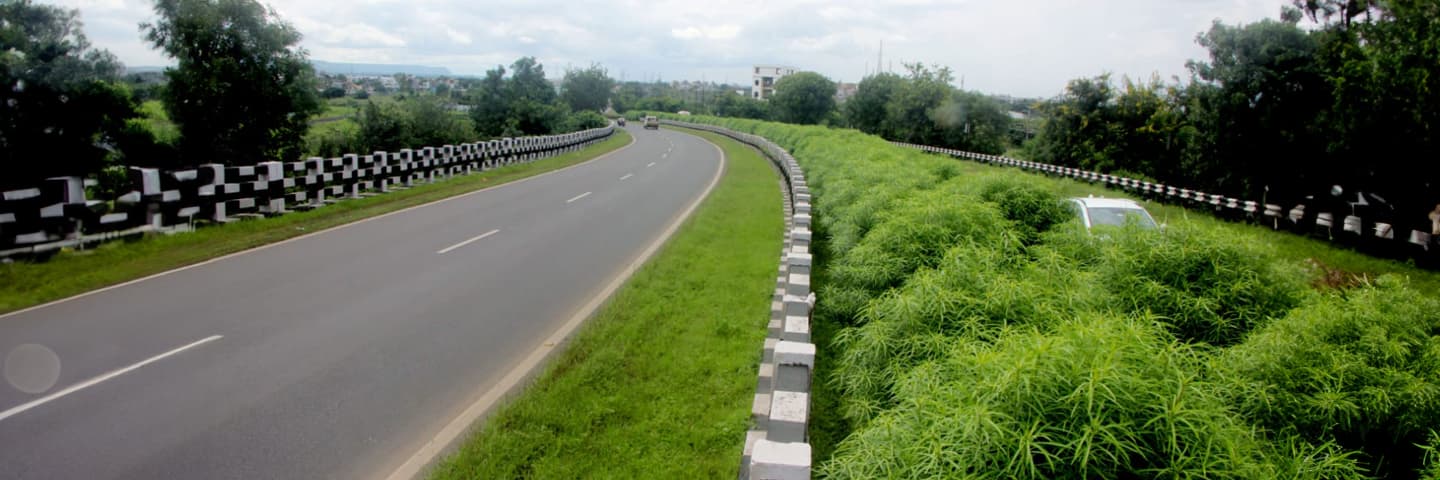Number of Lanes
4
Distance
65.8 Km
Original Concession Period
23.5 Years

The Chhatrapati Sambhaji Nagar – Jalna Road (MSH-6) project, along with the Beed Bypass and Zalta Bypass in Maharashtra, is a significant four-lane road project developed under the World Bank Project. This project commenced commercial operations (tolling) on July 27, 2009, with the Final Completion Certificate awarded on January 27, 2016.
The project covers a total length of 65.8 kilometres and includes key components such as the Beed bypass (from KM 292/500 to 305/650), Zalta Bypass (from KM 0/00 to 2/850), and a 3.8-kilometre section of the Chhatrapati Sambhaji Nagar – Jalna Road (from KM 10/400 to 14/200).
The project corridor spans two major industrial cities and comprises 46 kilometres of four-lane construction, including 2 railway overbridges (ROBs), 4 major bridges, 12 minor bridges, five truck laybys, two amenities, and two toll plazas. It primarily serves heavy commercial vehicles travelling between Nagpur and Pune.
Benefits of the Project Road
Enhanced Connectivity: The project road has significantly improved connectivity by connecting previously isolated regions to major urban centres, facilitating the movement of goods, services, and people. This enhanced connectivity has a positive impact on regional development.
Improved Safety: Safety enhancements, including better signage and wider lanes, have resulted in a reduction in accidents and fatalities on the road, making travel safer for all road users.
Reduced Travel Times: The modernization of the project road has led to a significant reduction in travel times for both daily commuters and long-haul transportation, increasing travel efficiency and reducing fuel consumption. This translates to cost savings and environmental benefits.
Economic Growth: The Jalna district, known for its strong industrial background in sectors such as seeds and steel, has witnessed substantial economic growth due to improved road infrastructure. The industrial development in Jalna encompasses engineering, plastics, and agriculture, and includes various industries like pulses mills, oil mills, refineries, steel re-rolling, plastics, tiles, cement pipes, fertilizers, insecticides, pesticides, and co-operative sugar factories.
Impact on Road Users
Commuters: Commuters now experience shorter travel times and increased safety, significantly improving their quality of life. Reduced travel times and enhanced safety measures make daily commuting more efficient and secure.
Truck Drivers: Long-haul truck drivers benefit from reduced transit times and lower operating costs, which boosts the efficiency of the logistics industry. This not only reduces transportation costs but also ensures more timely and reliable deliveries.
Tourists: Chhatrapati Sambhaji Nagar, a popular tourist destination, offers a unique blend of artistic silk fabrics, educational institutions, and proximity to the Ellora and Ajanta cave temples, designated as UNESCO World Heritage sites. The improved road infrastructure has made the region even more attractive to tourists, leading to increased tourism and greater support for local hospitality businesses.
Impact on Communities
Economic Development: Local communities have experienced notable economic growth due to increased economic activity. The region has seen the establishment of new businesses, particularly in manufacturing and tourism-related enterprises. The development of these sectors has contributed to economic prosperity and opportunities for the local population.
Employment Opportunities: The project has created employment opportunities for residents in various fields, including construction, maintenance, and other activities related to project development and maintenance, including toll operations. These job opportunities have been a source of livelihood for the local workforce, supporting their financial well-being.
Infrastructure Development: Chhatrapati Sambhaji Nagar, recognized as one of the fastest-growing cities with substantial investment and growth potential, has further solidified its position as a stronghold of global innovative manufacturing. The project has spurred the growth of ancillary infrastructure, such as hotels, restaurants, and service stations, benefiting local entrepreneurs. This growth in infrastructure enhances the region's appeal for businesses and travellers alike.
Environmental Impact: The project has prioritised environmental preservation and sustainable development. By planting more than 3,500 trees along the road corridor, the project contributes to ecological sustainability and green initiatives, ensuring a positive impact on the environment.
Accolades
The project has been certified under six ISO certification categories:
- ISO 9001:2015 Quality Management System
- ISO 14001:2015 Environmental Management System
- ISO 39001:2012 Road Traffic Safety Management System
- ISO 45001:2018 Occupational Health and Safety Management System
- ISO 31000:2018 Risk Management
- ISO 27001:2022 Information Security and Management System
Chhatrapati Sambhaji Nagar-Jalna Tollway Private Limited (formerly, Aurangabad - Jalna Toll Way Private Limited) (CSJTPL)
CIN: U45203TN2007PTC165196

